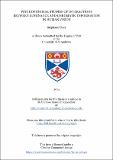Files in this item
Psychophysical studies of interactions between luminance and chromatic information in human vision
Item metadata
| dc.contributor.author | Clery, Stéphane | |
| dc.coverage.spatial | xxi, 260 p. | en_US |
| dc.date.accessioned | 2015-03-27T10:08:57Z | |
| dc.date.available | 2015-03-27T10:08:57Z | |
| dc.date.issued | 2014-06-24 | |
| dc.identifier.uri | https://hdl.handle.net/10023/6376 | |
| dc.description | Electronic version excludes material for which permission has not been granted by the rights holder | en |
| dc.description.abstract | In this thesis, I investigated how human vision processes colour and luminance information to enable perception of our environment. I first tested how colour can alter the perception of depth from shading. A luminance variation can be interpreted as either variation of reflectance (patterning) or variation of shape. The process of shape-from-shading interprets luminance variation as changes in the shape of the object (e.g. the shading on an object might elicit the perception of curvature). The addition of colour variation is known to modify this shape-from-shading processing. In the experiments presented here I tested how luminance driven percepts can be modified by colour. My first series of experiments confirmed that depth is modulated by colour. I explored a larger number of participants than previously tested. Contrary to previous studies, a wide repertoire of behaviour was found; participants experienced variously more depth, or less depth, or no difference. I hypothesised that the colour modulation effect might be due to a low-level contrast modulation of luminance by colour, rather than a higher-level depth effect. In a second series of experiments, I therefore tested how the perceived contrast of a luminance target can be affected by the presence of an orthogonal mask. I found that colour had a range of effects on the perception of luminance, again dependant on the participants. Luminance also had a similar wide range of effects on the perceived contrast of luminance targets. This showed that, at supra-threshold levels, a luminance target’s contrast can be modulated by a component of another orientation (colour or luminance defined). The effects of luminance and colour were not following a particular rule. In a third series of experiments, I explored this interaction at detection levels of contrast. I showed cross-interaction between luminance target and mask but no effects of a colour mask. | en_US |
| dc.description.sponsorship | Funded by the EPSRC - grant EP/G038708/1 | en |
| dc.language.iso | en | en_US |
| dc.publisher | University of St Andrews | |
| dc.rights | Creative Commons Attribution-NonCommercial-NoDerivatives 4.0 International | |
| dc.rights.uri | http://creativecommons.org/licenses/by-nc-nd/4.0/ | |
| dc.subject | Colour perception | en_US |
| dc.subject | Luminance perception | en_US |
| dc.subject | Shape perception | en_US |
| dc.subject.lcc | BF241.C6 | |
| dc.subject.lcsh | Brightness perception | en_US |
| dc.subject.lcsh | Color vision | en_US |
| dc.subject.lcsh | Space perception | en_US |
| dc.title | Psychophysical studies of interactions between luminance and chromatic information in human vision | en_US |
| dc.type | Thesis | en_US |
| dc.contributor.sponsor | Engineering and Physical Sciences Research Council (EPSRC) | en_US |
| dc.type.qualificationlevel | Doctoral | en_US |
| dc.type.qualificationname | PhD Doctor of Philosophy | en_US |
| dc.publisher.institution | The University of St Andrews | en_US |
This item appears in the following Collection(s)
Except where otherwise noted within the work, this item's licence for re-use is described as Creative Commons Attribution-NonCommercial-NoDerivatives 4.0 International
Items in the St Andrews Research Repository are protected by copyright, with all rights reserved, unless otherwise indicated.


